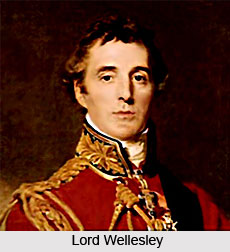 Military organisation under British was well maintained and quite large. Politically and militarily the English established themselves firmly in Bengal and began to give armed support to all disaffected parties. There was large scale disbandment, amalgamation and reduction in the establishment of the Indian troops. Indian artillery was abolished and henceforth this branch of the army was manned exclusively by Europeans. All the forts were to be manned by British artillery. Further, all cavalry was organised on the Silladar system except three regiments of the Madras army. With the decrease in the number of Indian troops the European contingent was increased. British officers and men were transferred from the British East India Company`s service to the Queen`s service. The European troops of the Company were eliminated and hence forth the army had only two types of troops namely British troops and Indian troops. The ratio of Indian and British troops in so far as infantry and cavalry were concerned was fixed at two to one for Bengal army and three to one for Bombay and Madras.
Military organisation under British was well maintained and quite large. Politically and militarily the English established themselves firmly in Bengal and began to give armed support to all disaffected parties. There was large scale disbandment, amalgamation and reduction in the establishment of the Indian troops. Indian artillery was abolished and henceforth this branch of the army was manned exclusively by Europeans. All the forts were to be manned by British artillery. Further, all cavalry was organised on the Silladar system except three regiments of the Madras army. With the decrease in the number of Indian troops the European contingent was increased. British officers and men were transferred from the British East India Company`s service to the Queen`s service. The European troops of the Company were eliminated and hence forth the army had only two types of troops namely British troops and Indian troops. The ratio of Indian and British troops in so far as infantry and cavalry were concerned was fixed at two to one for Bengal army and three to one for Bombay and Madras.
A battalion was raised in Bengal in 1757. In 1759 six more battalions were raised in Madras while Bombay also followed suit soon after. With these increases the post of the Indian Commandant was abolished and an English Commandant and company commanders took his place. At this time, the Company`s European troops were recruited from among as many sailors as could be spared from the ships on the coast and men of all nationalities smuggled or kidnapped for the purpose. For the first time Indians were also accepted as members of Regimental and General Courts Martial. The first re-organisation of the Company`s army in India took place in the year 1796. The Military Accounts Departments of the three Presidency armies had already been amalgamated in 1764 to facilitate effective control over military expenditure. Under the new organisation the number of the regiments was fixed at eleven. Each regiment had a colonel as Commandant. An infantry battalion consisted of 22 English officers. With these increases the authority of the Indian officers was reduced still further. The Indian cavalry regiments also had their full compliment of English officers. The regiments were reorganised by linking together the existing battalions and amalgamating the half battalions. There was very little in common between the units of the same regiment. With these changes the units had necessarily to be numbered again.
The second re-numbering of infantry units was started in the year 1824 when the two battalion regiments were broken up once again and the one battalion regimental system was evolved. The numbering was done on a Presidency basis according to the dates on which the units were raised. Local troops were also raised for service in Assam, Nagpur and Oudh. With the increase in the influence and authority of the English, Lord Wellesley, the Governor-General, introduced a novel method of raising troops. Under the Subsidiary Alliance the Indian princes were required to maintain a certain number of troops for their own defence. For all purposes these troops served the interests of the English and they did not have to spend anything on their maintenance and upkeep. All the cavalry units were then organised on the silladar system where the men provided their own chargers, arms and uniforms except their breach-loading rifles and equipment.
Up to 1857 recruitment to the various armies was on their own pattern. The Madras and Bombay armies enrolled personnel from their own Presidencies as well as from the rich recruiting areas of the north consisting of Sikhs, Jats, Rajputs, Brahmins and others. After 1857 the policy of water-tight compartments was enforced throughout the Indian army with the exception of the Sikh and Gorkha regiments. All regiments were organised on the basis on the `class company regiments`. The army was further re-organised in 1861 and this was completed within the next four years. One notable feature of the new scheme was that the number of English officers in the regular cavalry and infantry units was reduced to six per unit. By 1865 the army under the British had a total of 42 cavalry regiments, 142 infantry regiments, nine artillery batteries and three sappers and miners units. The Bengal army had 19 cavalry regiments, 49 infantry battalions and one sappers and miners unit. The Madras army had four cavalry regiments, 40 infantry battalions and one sappers and miners unit. The Punjab Frontier Force had six cavalry regiments, 12 infantry battalions and five artillery batteries. The Hyderabad Contingent consisted of four cavalry regiments, six infantry battalions and four batteries. By 1876 all the Remount Departments were also amalgamated. As compared to the Bombay and Madras armies the Bengal army still had a high proportion of Brahmins and Rajputs. Thus, such large military establishments meant an increase in the military budget.




















